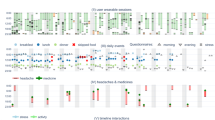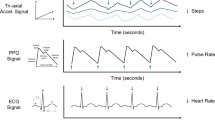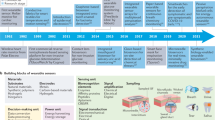Abstract
Personal exposure sampling provides the most accurate and representative assessment of exposure to a pollutant, but only if measures are implemented to minimize exposure misclassification and reduce confounders that may cause misinterpretation of the collected data. Poor compliance with personal sampler wearing protocols can create positive or negative biases in the reported exposure concentrations, depending on proximity of the participant or the personal sampler to the pollutant source when the monitor was not worn as instructed. This paper presents an initial quantitative examination of personal exposure monitor wearing protocol compliance during a longitudinal particulate matter personal exposure monitoring study of senior citizens of compromise health in North Carolina. Wearing compliance varied between participants because of gender or employment status, but not longitudinally or between cohorts. A minimum waking wearing compliance threshold, 0.4 for this study of senior citizens, is suggested to define when personal exposure measurements are representative of a participant's exposure. The ability to define a minimum threshold indicates data weighting techniques may be used to estimate a participant's exposure assuming perfect protocol compliance.
This is a preview of subscription content, access via your institution
Access options
Subscribe to this journal
Receive 6 print issues and online access
$259.00 per year
only $43.17 per issue
Buy this article
- Purchase on SpringerLink
- Instant access to full article PDF
Prices may be subject to local taxes which are calculated during checkout





Similar content being viewed by others
References
Schwartz J. Daily deaths associated with air pollution in six US cities and short-term mortality displacement in Boston. In: Revised Analyses of Time-Series Studies of Air Pollution and Health. Special Report. Health Effects Institute: Boston, MA, 2003, pp. 219. Available at: http://pubs.healtheffects.org/view.php?id=4 (18 October, 2004).
Zanobetti A., and Schwartz J. Airborne particles and hospital admissions for heart and lung disease. In: Revised Analyses of Time-Series Studies of Air Pollution and Health. Special report. Health Effects Institute: Boston, MA, 2003, pp. 241–248. Available at: http://pubs.healtheffects.org/view.php?id=4 (18 October, 2004).
Dockery D., Pope III C.A., Xu X., Spengler J.D., Ware J.H., Fay M.E., Ferris B.J., and Speizer F.E. An association between air pollution and mortality in 6 US cities. N Engl J Med 1993: 329: 1753–1759.
Rodes C.E., and Thornburg J. Breathing zone exposure assessment. In: Ruzer L.S., and Harley N.H. (Eds.) Aerosols Handbook: Measurement, Dosimetry, and Health Effects. CRC Press, Boca Raton, FL, 2004 p. 61.
Williams R., Suggs J., Creason J., Rodes C., Lawless P., Kwok R., Zweidinger R., and Sheldon L. The 1998 Baltimore Particulate Matter Epidemiology-Exposure Study: Part 1. Comparison of residential indoor, outdoor, and ambient particulate matter concentrations. J Expo Anal Environ Epidemiol 2000a: 10: 518–532.
Rodes C.E., Lawless P.A., Evans G.F., Sheldon L.S., Williams R.W., Vette A.F., Creason J.P., and Walsh D. The relationships between personal PM exposures for elderly populations and indoor and outdoor concentrations for three retirement center scenarios. J Expo Anal Environ Epidemiol 2001: 11: 103–115.
Thornburg J., Rodes C.E., Lawless P.A., Stevens C.D., and Williams R.W. A pilot study of the influence of residential HAC duty cycle on indoor air quality. Atmos Environ 2004: 38: 1567–1577.
McBride S., Williams R., and Creason J. Bayesian hierarchical modeling of personal exposure to particulate matter. Atmos Environ 2007: 41: 6143–6155.
Williams R., Rea A., Vette A., Croghan C., Whitaker D., Wilson H., Stevens C., McDow S., Burke J., Fortmann R., Sheldon L., Thornburg J., Phillips M., Lawless P., Rodes C., and Daughtrey H. The design and field implementation of the Detroit Exposure and Aerosol Research Study (DEARS). J Expo Sci Environ Epidemiol 2009: 19: 643–659.
Rodes C., Lawless P., Thornburg J., Croghan C., Vette A., and Williams R. DEARS particulate matter relationships for personal indoor outdoor, central site settings for a general population cohort. Atmos Environ 2010: 44: 1386–1399.
Wallace L., and Williams R. Use of personal-indoor-outdoor sulfur concentrations to estimate the infiltration factor, outdoor exposure factor, penetration coefficient, and deposition rate for individual homes. Environ Sci Technol 2005: 39: 1707–1714.
Wallace L., Williams R., Rea A., and Croghan C. Continuous week long measurements of personal exposures and indoor concentrations of fine particles for 37 health-impaired North Carolina residents for up to four seasons. Atmos Environ 2006: 40: 399–414.
Wallace W., Williams R., Suggs J., and Jones P. Estimating Contributions of Outdoor Fine Particles to Indoor Concentrations and Personal Exposures: Effects of Household Characteristics and Personal Activities. ORD Report (APM 214). EPA/600/R-023. Washington, DC, 2006.
Janssen N.A.H., Hoek G., and Brunekreef B., et al. Personal sampling of particles in adults: relation among personal, indoor, and outdoor air concentrations. Am J Epidemiol 1998: 147: 537–547.
Adgate J.L., Ramachandran G., and Pratt G.C., et al. Spatial and temporal variability in outdoor, indoor, and personal PM2.5 exposure. Atmos Environ 2002: 36: 3255–3265.
Liu L-J., Box M., Kalman D., Kaufman J., Koenig J., Larson T., Lumley T., Sheppard L., and Wallace L. Exposure assessment of particulate matter for susceptible population in Seattle. Environ Health Perspect 2003: 111: 909–918.
Turpin B.J., Weisel C.P., Morandi M., Colome S., Stock T., Eisenreich S., and Buckley B. Relationships of Indoor, Outdoor, and Personal Air (RIOPA): part II. Analyses of concentrations of particulate matter species. Res Rep Health Eff Inst 2007: 130 (Part 2): 1–77; discussion 79-92.
Williams R., Suggs J., Rea A., Leovic K., Vette A., Croghan C., Sheldon L., Rodes C., Thornburg J., Ejire A., Herbst M., and Sanders Jr W. The Research Triangle Park particulate matter panel study: PM mass concentration relationships. Atmos Environ 2003a: 37: 5349–5363.
Brook R., Shin H., Bard R., Burnett R., Vette A., Croghan C., Thornburg J., Rodes C., and Williams R. Exploration of the rapid effects of personal fine particulate matter exposure on arterial hemodynamics and vascular function during the same day. Environ Health Perspect 2011: 119: 688–694.
Delfino R.J., Staimer N., Gillen D., Tjoa T., Sioutas C., Fung K., George S.C., and Kleinman M.T. Personal and ambient air pollution is associated with increased exhaled nitric oxide in children with asthma. Environ Health Perspect 2006: 114: 1736–1743.
Pellizzari E., Lioy P., Quackenboss J., Whitmore R., Clayton A., Freeman N., Waldman J., Thomas K., Rodes C., and Wilcosky T. Population-based exposure measurements in EPA Region 5: A Phase I field study in support of the National Human Exposure Assessment Survey. J Environ Epi 1995: 5 (3): 327–358.
Lawless P.A., U.S. Patent 6,502,469B2, 2003.
Ebelt S., Petkau A.J., Vedal S., Fisher T.V., and Brauer M. Exposure of chronic obstructive pulmonary disease patients to particulate matter: relationships between personal and ambient air concentrations. J Air Waste Manag Assoc 2000: 50: 1081–1094.
Delfino R.J., Quintana P.J.E., Floro J., Gastañaga V.M., Samimi B.S., Kleinman M.T., Liu L.-J.S., Bufalino C., Wu C.-F., and McLaren C.E. Association of FEV1 in asthmatic children with personal and microenvironmental exposure to airborne particulate material. Environ Health Perspect 2004: 112: 932–941.
Liu W., Zhang J., Zhang L., Turpin B., Weisel C., Morandi M., Stock T., Colome S., and Korn L. Estimating contributions of indoor and outdoor sources to indoor carbonyl concentrations in three urban areas of the United States. Atmos Environ 2006: 40: 2202–2214.
Liu W., Zhang J., Korn L., Zhang L., Weisel C.P., Turpin B.J., Morandi M.T., Stock T.S., and Colome S. Predicting personal exposure to airborne carbonyls using residential measurements and time/activity data. Atmos Environ 2007: 41: 5280–5288.
Williams R., Suggs J., Rea A., Sheldon L., Rodes C., and Thornburg J. The Research Triangle Park particulate matter panel study: modeling ambient source contribution to personal and residential PM mass concentrations. Atmos Environ 2003b: 37: 5365–5378.
Howard-Reed C., Rea A.W., Zufall M.J., Burke J.M., Williams R.W., Suggs J.C., Sheldon L.S., Walsh D., and Kwok R. Use of a continuous nephelometer to measure personal exposure to particles during the U.S. Environmental Protection Agency Baltimore and Fresno panel studies. J Air Waste Manag Assoc 2000: 50: 1125–1132.
Rea A.W., Zufall M.J., Williams R.W., Sheldon L., and Howard-Reed C. The influence of human activity patterns on personal PM exposure: a comparative analysis of filter-based and continuous particle measurements. J Air Waste Manag Assoc 2001: 51: 1271–1279.
Zhao W., Hopke P.K., Gelfand E.W., and Rabinovitch R. Use of an expanded receptor model for personal exposure analysis in schoolchildren with asthma. Atmos Environ 2007: 41: 4084–4096.
Brook R., Bard R., Burnett R., Shin H., Vette A., Croghan C., Stevens C., Phillips M., Rodes C., Thornburg J., and Williams R. The associations between daily community and personal fine particulate matter levels with blood pressure and vascular function among non-smoking adults. J Occup Environ Med 2011: 68: 224–230.
Acknowledgements
The US Environmental Protection Agency, through its Office of Research and Development, partially funded the research described here through Contract 68-D-99-021 (RTI International), EP-D-04-065 and EP-D-68-00-206 (Alion Science and Technology), and EP-D-04-068 (Battelle Columbus Laboratories). Mention of trade names or commercial products does not constitute an endorsement or recommendation for use. Carry Croghan and Carvin Stevens of the US EPA are acknowledged for their assistance in data validation.
Author information
Authors and Affiliations
Corresponding author
Ethics declarations
Competing interests
The authors declare no conflict of interest.
Rights and permissions
About this article
Cite this article
Lawless, P., Thornburg, J., Rodes, C. et al. Personal exposure monitoring wearing protocol compliance: An initial assessment of quantitative measurement. J Expo Sci Environ Epidemiol 22, 274–280 (2012). https://doi.org/10.1038/jes.2012.8
Received:
Accepted:
Published:
Issue date:
DOI: https://doi.org/10.1038/jes.2012.8
Keywords
This article is cited by
-
Using time-resolved monitor wearing data to study the effect of clean cooking interventions on personal air pollution exposures
Journal of Exposure Science & Environmental Epidemiology (2023)
-
Protocol for a cluster randomised controlled trial of LPG cookstoves compared to usual cooking practices to reduce perinatal mortality and morbidity in rural Bangladesh called Poriborton: the CHANge trial
Trials (2022)
-
Long-standing LPG subsidies, cooking fuel stacking, and personal exposure to air pollution in rural and peri-urban Ecuador
Journal of Exposure Science & Environmental Epidemiology (2020)
-
Cardiovascular impacts and micro-environmental exposure factors associated with continuous personal PM2.5 monitoring
Journal of Exposure Science & Environmental Epidemiology (2014)



